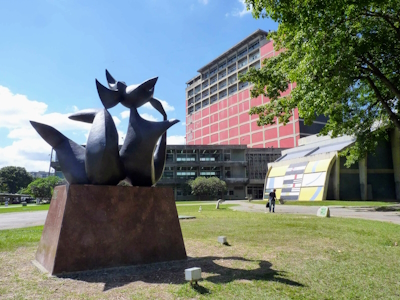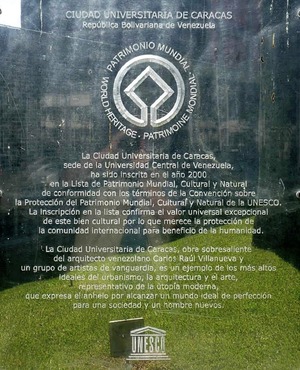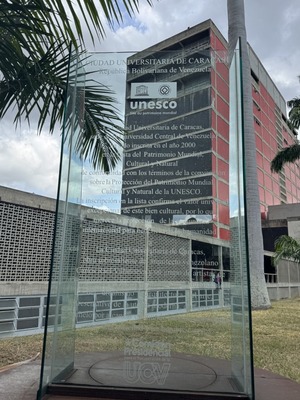Ciudad Universitaria de Caracas

The Ciudad Universitaria de Caracas (University of Caracas) is an outstanding example of the Modern Movement in architecture.
The University Campus was constructed between 1940 and 1960 by the Venezuelan architect Carlos Raúl Villanueva. He used the latest avant-garde ideas in architecture and spatial elements from Venezuelan colonial architecture suited to the tropical climate to create an open and ventilated solution. The complex also includes masterpieces of visual arts, like the "Clouds" of Alexander Calder.
Community Perspective: the campus is easily accessible by metro, and despite all the concrete a visit is interesting enough to see location-specific solutions such as “passages allowing students to walk in shadow during sunny days”. Solivagant ponders the University’s merits as a WHS.

Map of Ciudad Universitaria de Caracas
Load mapCommunity Reviews
Solivagant

The Ciudad Universitaria de Caracas is, with UNAM (Mexico), one of 2 inscribed mid 20th Century Latin American University campuses – is this either a surprising coincidence or evidence of some genuine value in unexpected locations?
It is situated in the South East of this narrow east/west oriented city and is accessible by metro to the eponymous station. We had driven through it quickly on a previous visit to Caracas many years ago but, on our second visit, gave it more time on foot in the hope that it would yield more “value”. The place is not set up for tourists (or WHS enthusiasts!) and our greatest disappointment was that we couldn’t get into the “Aula Magna” – the University’s main hall for concerts etc. This building is “famed” for the acoustic “clouds” (also dubbed “flying saucers”) by Alexander Calder, the “inventor” of mobile sculptures. As the other reviewers have noted, a particular aspect of the campus is the presence of long concrete covered walkways between the various buildings. We also visited the botanical gardens which are situated to the right of the northern entrance. We did so originally solely to have a pleasant walk through tropical plants away from the city bustle and hadn’t realized that they are a fully WHS-Inscribed part of the university and hold the botany faculty. We were “royally” welcomed by the staff when our Taxi driver who had brought us up from the port city of La Guaira rather warmed to the idea of being a fully-fledged “city guide” and went in search of those in charge to look after his “important” visitors! Unfortunately he couldn’t work the same magic with the Aula Magna
After a morning visit we left still unconvinced regarding the Caracas University’s merits as a WHS. OK. – so it was planned and designed in the early 1950s in “Modern Movement” style as a “consistent complex” by just one architect. Wikiarquitectura says that “It brings together a large number of buildings and functions arranged in a neatly intertwined complex and enriched with masterpieces of modern architecture and other arts, in what has been called the "Synthesis of the Major Arts," which finds its highest expression in the Aula Magna,” It certainly has its interests (there are some nice courtyards, murals and statues – see photo) so maybe its position in architectural history is greater than is “visible” but to us it looked suspiciously like just another grandiose concept worked out in, now crumbling, concrete of no greater merit than many other complexes of that era around the world – to us it lacked the memorable and even iconic aspects of UNAM.
It is perhaps interesting to look at and compare the criteria assigned to the 2 Latin American university sites by UNESCO. Both are inscribed under Criteria i - Human creative genius and iv - Significance in human history. UNAM was also assigned criterion ii - Interchange of Values on the basis that “The most important lines of architectural thinking from the 20th century converge in the Central University City Campus of UNAM: Modern Architecture, Historicist Regionalism, and Plastic Integration; the last two of Mexican origin.” The AB evaluation for Caracas shows that Venezuela also proposed to use Criterion ii on the basis that “The University represents the fulfilment in Latin America of a great part of the propositions made by the artistic and architectural avant-garde movements of the early 20th century in Europe. It constitutes an outstanding example in a small enclosure of a utopian world reflecting that time and expressing the quality of modern urbanism, the application of modern technology, the creation of modern abstract forms, and the construction of a spatial integration of inside and outside reflected in the dimension of time. The ensemble represents the best example of the integration of the works of avant-garde artists.” No explanation is given in the evaluation as to why this was not accepted!
Jarek Pokrzywnicki

Site visited in March, 2011. Easy accessibile (close to a metro station), the whole area due to its university status looks pretty safe (at least during the daytime), security was the main concern while visiting Venezuela. At first it looks a little bit dissappointingly - all the buildings are made of concrete, they are modern (in terms of architecture style) but after a while you can spot that it is really an entire complex of different buildings but designed in the same manner. Architecture is simple but practical, some solutions are spectacular (those passages allowing students to walk in shadow during sunny days). So for me the place is interesting although I know that some people may be dissapointed.
Joseph Colletti
I visited the site in August 2009.
The non-architect may wonder at first what all the fuss is about but as you stroll along the concrete covered passageways and look around the vision of the architect slowly emerges. Whether or not you like the style, there is a cohension and obvious "stamp" of an individual on the buildings and landscape without any quality of boring sameness or jarring differences in style or architectural "interactions." That is what the inscription as a heritage site appears to celebrate.
I was surprised at how the use of concrete takes into account, for the most part, the tropical setting with open spaces, covered arcades, access to natural light and lines and curves that often blunt the heaviness one might associate with concrete.
There were buildings that needed repair, some more than others, and broken windows, leaks and cracks in some of the structures but the overall neglect the previous publisher noted seems to have been addressed in some cases. Some of the buildings, especially the student residences looked like government housing projects or cheap "garden apartments" while others, such as the cafeteria were truly unique in their design and use of space. Unfortunately the college was not in session and it was not possible to get a look inside some of the more intriguing structures such as the concert hall or to get a feel for how humans interact with the architectural space.
Depending on how interested you are in architecture an hour or so should be sufficient for a visit and it can be a welcome respite from the noise, heat and traffic jams of downtown Caracas.
The campus is easily accessible by the metro Ciudad Universitaria stop and is a great way to get around the city quickly and cheaply. (The fare was about 20 cents.)
Site Info
Site History
2000 Inscribed
Site Links
Unesco Website
Official Website
Related
In the News
Connections
The site has 10 connections
Art and Architecture
Geography
Human Activity
Science and Technology
Timeline
Visiting conditions
WHS on Other Lists
Visitors
58 Community Members have visited.

